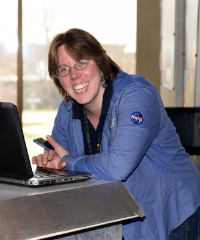Community Blogs
Community Blogs
Discover how the GLOBE community is engaging in all things GLOBE through the community blog posts below.
Learn how to create a GLOBE community blog post.
Filter By:
Blogs List
"With its antenna now spinning at full speed, NASA's new Soil Moisture Active Passive (SMAP) observatory has successfully re-tested its science instruments and generated its first global maps, a key step to beginning routine science operations next month."
Read more HERE !
Brian
Read More »
Posted in:
Hello reader! My name is George Duffy! I am a graduate student from the University of Urbana Champaign, and I am excited to begin sharing my experience as a GPM graduate researcher of with you.
My research focuses on snow, or more specifically, snowfall retrieval. Technically, the GPM satellite doesn't measure precipitation, it measures radar echoes from its Dual Frequency Precipitation Radar (DPR) and radiation from it's General Microwave Imager (GMI). It's up to us to develop algorithms that can retrieve precipitation information from these radar images. It's ...
Posted in:
The term “won in a landslide” is particularly troubling to me because when a landslide happens, the kind that I study at least, there are seldom “winners”. My research looks at how rainfall interacts with the environment to cause natural disasters like flooding and landslides. Knowing where, when and how much rain or snow is falling is key to understanding where we may have extreme events that can impact people.
If you consider where we get a lot of rainfall, like some of our tropical regions…
...and combine that with areas that have the right factors to cause a landslide, such ...
Posted in:
So, now that we have a satellite in space called SMAP, why is the data from the spacecraft so important?
SMAP will help:
Monitor Drought
Predict Floods
Assist Crop Productivity
Improve Weather Forecasting
Linking Water, Energy, and Carbon Cycles
Read more HERE
Posted in:
To find our where the SMAP spacecraft is, at any time in relation to my school, you can check on the S MAP Orbit Calculator Tool !
As you might have noticed in the SMAP Block Pattern Soil Moisture Protocol document, we recommend that measurements be taken and collected around 9:00am local time. This is due to the SMAP spacecraft's 6am and 6pm local time equator crossings. In order to have optimal SMAP comparison/validation data, it is vital to take your measurements as close to the 9am local time as possible.
Any questions, please contact me at Brian.A.Campbell@nasa.gov ...
Posted in:
Hi, my name is Anna Wilson. I moved to Asheville, NC in the summer of 2004, just before several floods caused by tropical storms left me without power for more than a week. This spurred my previously casual interest in the weather to become an obsession that eventually prompted me to go back to school. Here I am with a PARSIVEL disdrometer (an instrument that measures the size and velocity of particles that pass through its sampling area), after I completed my bachelor’s degree in Atmospheric Science and started working towards my PhD in Environmental Engineering:
(photo credit: ...
Posted in:
Hi Everyone,
This past week and a half has been rather quiet as we performed two orbital maneuvers. The first maneuver placed the spacecraft at an altitude closer to its final orbit. The second one slightly adjusted the inclination of the orbit to ensure that SMAP goes over the equator at approximately 6:00 am and 6:00 pm every day, which are the ideal times to obtain our science measurements.
For those of you wondering how SMAP maneuvers around, the spacecraft contains a single pressurized propellant tank carrying 81 kilograms (179 pounds) of hydrazine. The spacecraft adjusts ...
Posted in:
As you know, SMAP will be giving us unprecedented soil moisture data from around the Earth. But, did you know that SMAP is also looking at frozen soil?
Check out the article link below to learn more about this measurement and how it aligns to our better understanding of our ecosystem and climate change.
"Let It Go! SMAP Almost Ready to Map Frozen Soil"
SMAPtastic,
Brian
Posted in:
Hey All,
We just finished up a two-day GLOBE Train-the-Trainer Workshop at the GEMS World Academy in Chicago, Illinois. Trainers from across the USA came to learn about several NASA Earth Science Missions and their affiliation with GLOBE and associated protocols. Those missions are Cloud Satellite (Cloudsat), Global Precipitation Measurement (GPM), Soil Moisture Active Passive (SMAP), and Landsat.
On the SMAP side of things, we had a bit of a tough time digging out soil samples for the SMAP Block Pattern Soil Moisture Protocol due to snow/ice cover and partially frozen soil*. ...
Posted in:
Hi Everyone,
This past week has been smooth sailing as we tested both of our instruments, the radar and the radiometer. The radar’s high power transmitter was turned on as the spacecraft was flying over the North Atlantic and then over Greenland. The telemetry data looked great and the signals received clearly showed the transition from ocean to land (yay!). There were some biases with the data that still need to be worked out, however everything is working and we will have a better sense of the quality of the radar data once the antenna starts spinning. During this past week we also ...
Posted in:
Fresh off the recent successful deployment of its 20-foot (6-meter) reflector antenna and associated boom arm, NASA's new Soil Moisture Active Passive (SMAP) observatory has successfully completed a two-day test of its science instruments.
The observatory's radar and radiometer instruments were successfully operated for the first time with SMAP's antenna in a non-spinning mode on Feb. 27 and 28. The test was a key step in preparation for the planned spin-up of SMAP's antenna to approximately 15 revolutions per minute in late March. The spin-up will be performed in a two-step process ...
Posted in:
WOW! If you are not amazed by this GPM Data Visualization loop, you should be!
( www.youtube.com/embed/ILNC7IdyWVU?enablejsapi=1&rel=0 )
Earth SySTEM is an approach to STEM Education that utilizes the current and future technological infrastructure of satellite imagery, remote sensing, and computer visualizations, and data archives in the study of Earth as a System .
So the question becomes, besides being pretty pictures, what else can students do with these types of satellite images, remote sensing and computer visualizations? There are many ...
Posted in:
Hi Everyone,
The major milestone this past week was the deployment of the reflector antenna/boom assembly (RBA), which refers to a 5-meter (~16 foot) long boom that holds a 6-meter (~20 foot) diameter antenna at the end of it. For launch the RBA was folded against the spacecraft to fit within the launch vehicle fairing. The boom and antenna together weigh 58 kilograms (127 pounds). Yes, super light for something that size. The boom is a carbon composite structure, made of multiple layers of carbon fiber cloth that are impregnated with a special resin, then baked to create a ...
Posted in:
Last Friday, February 27th, was the one-year anniversary of the launch of the Global Precipitation Measurement Mission Core Observatory, and coinciding with that event, released its first global map of rainfall and snowfall, covering the period from April 2014 to September 2014. The data map combines measurements from 12 satellites and the GPM Core Observatory, which serves to unify the data from all the satellites, like the lead violin in an orchestra tuning the rest of the instruments. The result is NASA's Integrated Multi-satellite Retrievals for GPM data product, called IMERG, ...
Posted in:
Hi Everyone,
A lot has happened since my last posting. The mission operations team has been hard at work testing the spacecraft and learning its intricacies. Having a new satellite in space is like driving a new car, it takes a little while to learn how it behaves and reacts.
This past week we’ve been testing subsystems and making sure that temperatures and voltages are within range. Also, we have transitioned the spacecraft to point directly at the ground (nadir). While not everything has behaved as expected, the team has addressed some minor yet unexpected issues quickly and ...
Posted in:
WOW, WOW, WOW! Early Saturday morning, January 31, 2015, everything was a GO for the SMAP launch except the high altitude winds were too strong to proceed. Everyone was on edge and ten minutes before the scheduled launch time things turned for the better. The wind situation was deemed “green” and it was safe to continue. Whew!
The launch itself was an exhilarating experience. As the countdown reached the final two seconds there was a sudden boom, followed by a bright yellow/orange glow and a white cloud that mushroomed to the sides of the rocket. SMAP soared into the sky much faster ...
Posted in:
I was born and raised in Michigan’s Upper Peninsula. If you’re unfamiliar with this extreme northern region of Michigan, it is meteorologically famous for its snow. Lots of snow. Insane amounts of snow. Sled-from-your rooftop piles of snow (see below image). Driving a car in this winter wonderland is difficult since pavement is merely a rumor on most streets from November through April. While snow provides many anxious driving moments, it is also cherished for creating breathtaking winter landscapes and for providing a wide variety of winter outdoor ...
Posted in:
Chances are that if you are reading this blog you are interested in bringing the exciting world of satellites and remote sensing into your classroom. Over the past five decades NASA and NOAA have archived satellite imagery and datasets and there is high interest in educators using these resources from both agencies. However, the challenge to the precollege community over the years has been one of both acquiring the technical skills to retrieve such imagery and data, and having the computer power to acquire and store such large files. The good news is that while aerospace engineers ...
Posted in:
We're just over two weeks in to the campaign, and I wanted to give a shout out to those schools who have so far entered data. Some of them are entering data from multiple sites at their school to have so many data points in two weeks. Keep up the good work, and more updates coming soon!
School Name
City
State/Country
Data Entries February 1st through 15th
Sumarska i drvodjeljska skola
Karlovac
Croatia
29
Lourdes Public Charter School
Scio
Oregon, USA
20
OS Banija
Karlovac
Croatia ...
Posted in:
The SMAP team would like to give a shout out to the schools in Trinidad and Tobago, Croatia, and Oman that have already started taking measurements with the SMAP Block Pattern Soil Moisture Protocol .
We are excited to compare GLOBE student data to the SMAP spacecraft data, once the spacecraft starts taking soil moisture. The SMAP spacecraft is currently working on the phase when we raise the antenna boom and unfurl the collecting dish.
Thank you and keep the soil moisture data coming!
Brian
Posted in:
—
20 Items per Page












